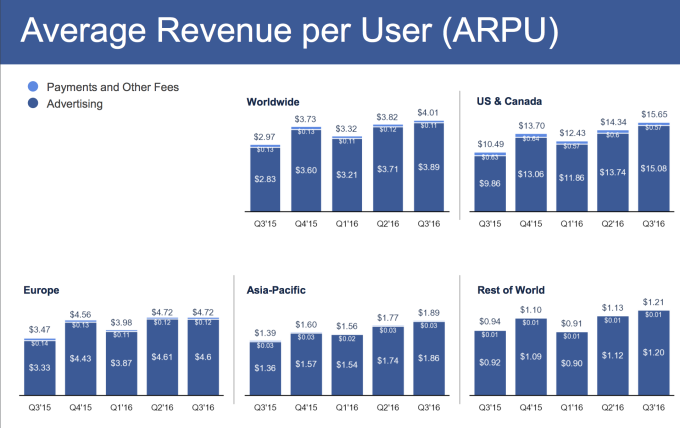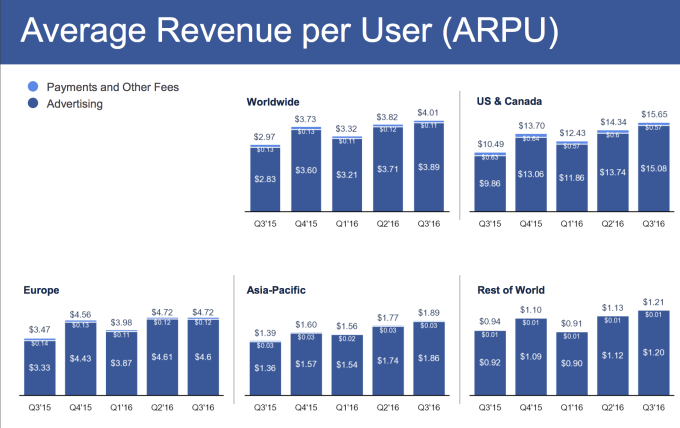
Mark Zuckerberg’s drive to “put video first” is also putting money in Facebook’s pockets. The more organic videos Facebook users watch, the more high-priced video ads Facebook can slip into the feed. Now Facebook’s strategy around auto-play video, paying Live content producers and offering more creative tools is helping to propel its massive revenue growth.
Facebook revealed yesterday during its strong quarterly earnings call that in the last year, Facebook’s average revenue per user grew 49.1 percent in the U.S. and Canada — Facebook’s home market where advertiser concentration, buying power and fast mobile networks make video and video ads popular. That’s compared to 35 percent growth worldwide. The U.S. and Canada’s ARPU grew 9.1 percent this quarter, faster than any other market.
In terms of viewership, Facebook has declined to share a stat since it announced 8 billion daily 3-second-plus views a year ago. But viewership has likely been growing dramatically, because as Mark Zuckerberg said on the earnings call:
“What is enabling video to become huge right now is that fundamentally the mobile networks are getting to a point where a large enough number of people around the world can have a good experience watching a video. If you go back a few years and you tried to load a video in News Feed it might have to buffer for 30 seconds before you watched it, which wasn’t a good enough experience for that to be the primary way that people shared. But now you can — it loads instantly. You can take a video and upload it without having to take five minutes to do that.”

The rise in video viewership also comes thanks to sharper cameras, bigger screens to watch on, better video creation tools and professional and amateur creators getting the hang of the mobile format.
Facebook’s begun adding Live video filters and effects, augmented reality selfie masks, overlaid graphics and more, built off of its acquisition of AR lens startup MSQRD. These are closing the feature gap between Facebook and its competitor, Snapchat.
While many believed Snapchat would steal Facebook’s users, the percentage of Facebook’s monthly visitors who come back daily has actually increased slightly since the rise of Snapchat in 2014. Holding steady at two-thirds of its user base, this stickiness stat is impressive for a 12.5-year-old utility.

Facebook is still sticky, with DAU/MAU holding strong
Continued user count growth, engagement and the ability to earn more per user via video ads has contributed to Facebook’s $7.01 billion in revenues this quarter, up 59 percent year-over-year, and its $2.35 billion in profit. Essentially, Facebook’s soft pivot to video worked.
Normalizing the video feed
Back in 2013, seeing video in the News Feed was rare. Uploading to Facebook was clumsy, and whether the clips were native or from YouTube, they took a click and some load time to start watching.
That’s why people were downright angry about the whole idea of Facebook planning auto-play video ads. The Wall Street Journal trumpeted “Facebook Moves Cautiously on Video Ads,” delaying their roll-out. And rightfully so. Without much organic video content, video ads would have stuck out like sore thumbs.
Yet suddenly over the course of 2014, with the roll-out of auto-play and the rise of the ALS Ice Bucket Challenge video meme, organic videos became more and more prevalent in the feed. Meanwhile, advertisers started to get the hang of the format. They cut the intros and went straight to the action, adopting eye-catching visuals and subtitles to make up for the fact that they played silently unless tapped.
Facebook COO Sheryl Sandberg said yesterday that “P&G is creating mobile video ads designed to grab attention in the first few seconds. He shared the example of Tide. In a typical TV ad, they start with a clean dress or shirt, then show it getting stained, and then cleaned with Tide. On mobile, they need to communicate the product value quickly, so they start by showing Tide cleaning a stained garment.”
Masked by the surrounding organic content and designed for Facebook instead of TV, video ads became a normal part of the News Feed. That gave Facebook the freedom to show more of them, both in the feed and as suggested videos after you watched another, without people getting too pissed off.
FaceTV
Now Facebook is putting its connections with 4 million advertisers behind video. That includes big brands. As Sandberg said yesterday, “GM’s subsidiary Holden used Carousel Ads with video to maximize its sponsorship of Australia’s premier rugby tournament. Holden created a video series about their support of youth rugby. The ads generated an 8-point lift in brand favorability for the overall audience — and a 15-point lift amongst their target audience of women over 35.”
Facebook is also bringing small businesses to the video format. Sandberg explained that “For many small businesses, the shift to mobile means leveraging video for the very first time. Rather than needing a camera crew and production budget, anyone with a smartphone can shoot a video and share it on Facebook. In the past month alone over 3 million small businesses have posted a video on Facebook, including organic posts and ads.”

Compared to less vivid text and photo posts, Facebook can charge more for video ads without using up more space. CFO David Wehner said yesterday that “The average price per ad increased 6 percent in Q3.” Adtech firm AdRoll’s CMO Adam Berke agrees that video is pushing that increase. He tells TechCrunch, “Video ads garner a higher CPM than other ad formats, so that will certainly help drive revenue growth…We’re seeing interest in these types of video ad formats from our install base of over 25,000 businesses that never would’ve bought TV ads.”
Snapchat, Twitter and other services are also trying to cash in on video, where YouTube and Facebook have become dominant.

Snapchat’s full-screen video ads compete with Facebook
Snapchat’s vertical layout allows for full-screen ads that can feel more impactful and convenient than Facebook’s typically landscape videos. People also typically watch Snapchat with the sound turned on so videos automatically play with audio, unlike on Facebook. People purposefully visit YouTube to watch a specific video, so they’re willing to sit through pre-roll ads. And Twitter is becoming a home for premium video streams like the NFL and presidential debates, which draw advertisers.
But Facebook has several advantages of its own. Its 1.79 billion user reach is appealing to TV advertisers seeking scale. Meanwhile, its success the last five years has financed a leading artificial intelligence research team that Facebook is applying to make sure videos and video ads reach the right people.
Zuckerberg noted yesterday that “There’s a whole thread of work that we’re doing on visual understanding. Right, so understanding photos, what’s in photos, what’s in videos, what people are doing. There’s some deeper AI research that we’re doing…that can apply to things like ranking for News Feed and Search and ads and all of our systems more broadly.”
Facebook gets paid when its video ads work, and AI will help them target the people they’re most likely to work on.

When Facebook popularized the feed-based social network people browse to discover content, it became a home to colorful brand ads. As users first shifted to mobile, it attracted app install ads from developers desperate to rise out of the crowded app stores. Now as mobile data networks strengthen to support high-bandwidth content, Facebook has built a powerful distribution network that video advertisers want to join.
As Sandberg concluded yesterday, “When we think about video ads and what platform they run on, we really believe that over time the dollars will shift with eyeballs and our goal is to be the best dollar and the best minute people spend measured across channels.” The numbers say those dollars have arrived.

